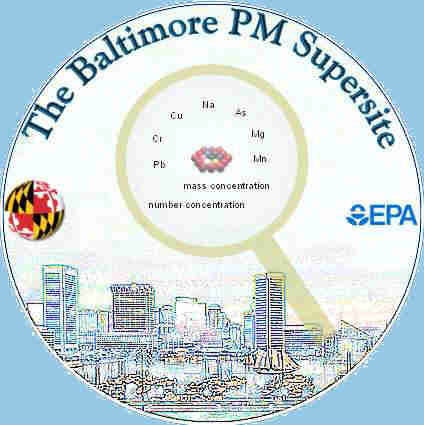 |
| Home |
| The Project |
| Why Baltimore |
| P.I.s |
| Science Team |
| SEAS |
| Lidar Data |
| MET Data |
| Sampling Sites |
| Publications -BSS |
| SOP |
| Related Links |
| Contacts |
| Picture Archive |
| Restricted area |
Last update
06/24/2002
| Project Summary | Hypotheses and Objectives | Project (pdf) |
|
Hypotheses and Objectives |
Our primary objectives will be to i) provide an extended, ultra high-quality multivariate data set, with unprecedented temporal resolution, designed to take maximum advantage of advanced new factor analysis and state-of-the-art multivariate statistical techniques; ii) provide important information on the potential for health effects of particles from specific sources and generic types of sources, iii) provide large quantities of well characterized urban PM for retrospective chemical, physical, biologic analyses and toxicological testing, iv) provide sorely needed data on the sources and nature of organic aerosol presently unavailable for the region, v) provide support to existing exposure and epidemiologic studies to achieve enhanced evaluation of health outcome-pollutant and -source relationships, and vi) test the specific hypothesis listed below.
-
Reduced (i.e., hourly and sub-hourly; two-hourly for organic compounds) sampling/analysis times will immensely improve source attribution.
-
Various health effects of PM are associated with its specific chemical and physical (but mostly chemical) components that, owing to the vast number of these, a source based allocation of air toxins will provide the most useful information for PM standards and control.
-
Different aerosol constituents and properties will have different abilities to elicit cytokine responses and that these difference might reflect differences in the extent and mode of action in producing adverse health effects. For example, residual oil fly ash elicits a response (largely attributed to V), whereas coal-fly ash elicits a lesser response.
-
Aerosol age affects the size, chemistry, and health effects of PM. Thus spatially distant upwind, industrial area, and center‑city aerosols differ significantly in temporal variability and biologically relevant composition.
-
Taken together, detailed sub-hourly information of major, minor, and trace inorganic and organic aerosol constituents, size-resolved aerosol particle concentrations, and cytokine responses will permit unprecedented resolution of sources of toxic PM components and their toxic effects.
-
24-hour and short-term concentrations, cytokine and ROS responses, and health effects of potentially toxic aerosol components in areas of Baltimore that are strongly influenced by heavy industry measurably exceed those observed in an urban downtown site that is weakly influenced by industrial sources.
-
Some acute health responses are more closely associated with highly elevated short-term exposures than they are with 24h averages.
-
Spatial distribution of various fine aerosol particle constituents are highly inhomogeneous due to both variations in sources and regional circulations.
Ancillary objectives include i) partnering with Maryland‰s Department of Environment to share resources, data, and expertise to reduce project costs and ensure assimilation of results into Maryland‰s SIP development process, and to ii) augment the body of data collected by EPA‰s National Exposure Research Laboratory (NERL) Laboratory during their 1997-1998 year-long advanced monitoring study. This will be a cooperative agreement. We look forward to working closely with EPA colleagues.